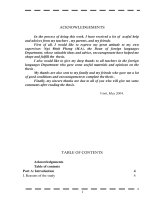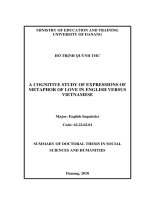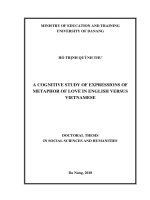A COGNITIVE STUDY OF EXPRESSIONS OF METAPHOR OF LOVE IN ENGLISH VERSUS VIETNAMESE
Bạn đang xem bản rút gọn của tài liệu. Xem và tải ngay bản đầy đủ của tài liệu tại đây (823 KB, 28 trang )
<span class="text_page_counter">Trang 1</span><div class="page_container" data-page="1">
<b>MINISTRY OF EDUCATION AND TRAINING UNIVERSITY OF DANANG </b>
</div><span class="text_page_counter">Trang 2</span><div class="page_container" data-page="2"><b>CHAPTER 1 INTRODUCTION 1.1. Rationale </b>
<i><b>A cognitive study of expressions of metaphor of love in English versus Vietnamese is chosen as the topic of our research for some reasons. (i) </b></i>
Love is one of the basic human emotions one but hardly definable. However, the love expressions are extremely diversified. (ii) Metaphor (including love metaphor) is pervasive in conventional daily language. (iii) The metaphorical expressions of romantic love that are categorized into terms of space, time and sensory perceptions are not investigated, especially those in English and Vietnamese. (iv) The study draws out some similarities and differences between English and Vietnamese metaphorical expressions of romantic love, which are expected to be of practical use to the process of learning, teaching and translating.
<b>1.2. Aims and objectives of the study </b>
<i><b>1.2.1. Aims of the study: to examine, compare and identify the factors </b></i>
influencing the expressions of metaphor of romantic love under three linguistic fields- space, time and sensory perceptions in English and Vietnamese poetry.
<i><b>1.2.2. Objectives of the study: to analyze, clarify and find out the </b></i>
similarities and differences between English and Vietnamese expressions of metaphor of romantic love in poetry. At the same time, the factors resulting in these similarities and differences are identified.
<b>1.3. Research questions </b>
To achieve the objectives of the study, the following questions need to be dealt with. (1) What expressions of space, time and sensory perceptions are metaphorically used to describe romantic love in
</div><span class="text_page_counter">Trang 3</span><div class="page_container" data-page="3">English and Vietnamese poetry? (2) What cognitive mechanism(s) can be constructed for understanding and interpreting romantic love via expressions of space, time and sensory perceptions? (3) How similar or different are terms of space, time and sensory perceptions expressing romantic love in English and Vietnamese poetry? (4) Which factor(s) contribute(s) to the similarities and differences between English and Vietnamese expressions of metaphor of love?
<b>1.4. Focus and scope of the study </b>
<i><b>1.4.1. Focus of the study </b></i>
Our study only focuses on English and Vietnamese metaphorical expressions of romantic love that are classified into three categories: space, time and sensory perceptions.
<i><b>1.4.2. Scope of the study </b></i>
The scope of the study is limited at the metaphorical expressions of romantic love gathered from English and Vietnamese love poems composed since the early 20<small>th</small> century under three categories: space, time and sensory perceptions. The expressions of other love kinds, beyond the registers or time periods are not examined.
<b>1.5. Justification for the study </b>
<i><b>1.5.1. Theoretical significance of the study </b></i>
The findings of the study help to spell out and enforce the CMT once again. Besides, a theoretical framework can be applied to subsequent researches of the similar interest.
<i><b>1.5.2. Practical significance of the study </b></i>
The study partly helps the readers understand more about the cultural values influencing on love expressions. The study findings can be
</div><span class="text_page_counter">Trang 4</span><div class="page_container" data-page="4">applied to learning, teaching and translation as well.
<b>1.6. Organization of the study Chapter 1. Introduction, </b>
<b>Chapter 2. Literature Review and Theoretical Background Chapter 3. Methodology </b>
<i><b>Chapter 4. Expressions of metaphor of love in English poetry Chapter 5. Expressions of metaphor of love in Vietnamese poetry </b></i>
<b>Chapter 6. Similarities and differences between English and Vietnamese expressions of metaphor of love in poetry </b>
<b>Chapter 7. Conclusions and implications 1.7. Summary </b>
<i>The chapter Introduction provides the readers with the reasons for the </i>
topic, aims and objectives, significances, research questions and an overview of the study.
<b>CHAPTER 2 </b>
<b>LITERATURE REVIEW AND THEORETICAL BACKGROUND </b>
<b>2.1. Theoretical background </b>
<i><b>2.1.1. The conceptual metaphor theory (CMT) </b></i>
According to the CMT, metaphor is pervasive in everyday life, not just in language but in thought and action.
2.1.1.1. The systematicity of conceptual metaphors
The CMT proves the systematicity in the conceptualization and in
<b>metaphorical linguistic expressions. </b>
2.1.1.2. Partialness of conceptual metaphors.
</div><span class="text_page_counter">Trang 5</span><div class="page_container" data-page="5">The CMT affirms that not all aspects of one concept are employed to talk about another; there are still some aspects hidden in the process of conceptualization.
2.1.1.3. Metaphorical coherence and understanding
It is the systematicity that creates the coherence and the understanding of a conceptual metaphor though it is single or complex.
2.1.1.4. Cognitive mechanism of conceptual metaphors
Conceptual metaphor is the understanding of one concept in terms of another through cross-domain mappings. They are the projections of basic knowledge elements from a source to a target in metaphors. 2.1.1.5. Types of conceptual metaphors
<i>a. Conventional metaphor: metaphors that make up the ordinary </i>
conceptual system manifested in our everyday language.
<i>b. Novel metaphor: metaphors going beyond our conventional conceptual </i>
system, providing us with the new understanding of our experience. 2.1.1.6. Limitations of the CMT
First, verbal manifestations by Lakoff and Johnson (1980a,b) as linguistic evidences for several conceptual metaphors are all de-contextualized. The second is lack of reliable criteria for metaphor identification in the CMT. The third is the question of determining the apt projection between the source and the target domains in a metaphor. However, the theory is more and more bettered and improved. The limitations have been basically remedied.
<i><b>2.1.2. Recent development in conceptual metaphor </b></i>
2.1.2.1. Categorization view of metaphor
The view makes use of an attributive category exemplified or typical
</div><span class="text_page_counter">Trang 6</span><div class="page_container" data-page="6">of an entity to attribute to another entity. 2.1.2.2. Blending theory of metaphor
Blending theory, or conceptual integration theory talks of metaphor as a conceptual (but not a linguistic) phenomenon activated by a systematic projection between 4 mental spaces including two inputs, a generic space and a blend space.
2.1.2.3. Neural theory of metaphor
Neural theory makes sense of metaphorical phenomena by using the so-called “primary metaphors”. The metaphorical use and understanding is grounded on embodiment and the extension of conceptual blending called neural binding.
<i><b>2.1.3. Expression of metaphor </b></i>
Metaphor is conceptual and manifested in language through linguistic
<i>expressions which is called expressions of metaphor (or metaphorical </i>
expressions, or linguistic metaphors).
<i><b>2.1.4. Metaphor and culture </b></i>
<b>Metaphor is a product of culture and under its influence. </b>
<i><b>2.1.5. Metaphor in literature and in poetry </b></i>
Poetic metaphors are made special by reworking conventional ordinary everyday metaphors by using four techniques: extending, elaboration, questioning and combining.
<i><b>2.1.6. Concepts of space, time and sensory perceptions </b></i>
2.1.6.1. Space: a boundless three-dimensional extent in which the location, movement, configuration and relationships between objects are identified.
2.1.6.2. Time: consisting of points and carnivals of time and
</div><span class="text_page_counter">Trang 7</span><div class="page_container" data-page="7">represented as past, present, future, etc., including chronos and kairos. 2.1.6.3. Sensory perception: any description involving one or more of the five senses –sight, smell, sound, taste and touch.
<i><b>2.1.7. Love as an emotion </b></i>
Love is any of a number of emotions related to a sense of strong
<i><b>affection and personal attachment. 2.1.8. Conceptual metaphors of love </b></i>
The list of 24 metaphors of love raised by Lakoff and Johnson and Kovecses, three emotional ones and the other found by previous studies are grouped into 17 metaphors with the source domains of captive animal, container, disease, fire, force, game, journey, living organism, magic, nutrient, opponent, rapture, unity, blindness, climate, plant, and the sun/moon. These domains are used in our study.
<b>2.2. Previous studies of metaphors of love </b>
There have been many researches on conceptual metaphors of love in the light of the CMT. Besides their contributions to new source domains used for love, most of them shared a common limitation of metaphor identification.
<b>2.3. Summary </b>
The chapter has presented the theoretical problems relating to the study. They consists of the CMT and recent development in conceptual metaphors, the concepts of space, time and sensory perceptions, metaphors of love and previous studies of love metaphors.
<b>CHAPTER 3 METHODOLOGY 3.1. Research design </b>
</div><span class="text_page_counter">Trang 8</span><div class="page_container" data-page="8"><i><b>3.1.1. Inductive approach </b></i>
Inductive approach was made used of to identify linguistic metaphors in discourse, eliciting corresponding conceptual metaphors underlying them, and find out the novelty of love metaphors existing in poetry.
<i><b>3.1.2. Qualitative and quantitative methods </b></i>
The qualitative was applied to seek the specific information related to the topic and provided the study with appropriate samples. The quantitative involved the quantification and statistical treatment of the data collected in order to approve or disapprove of a hypothesis.
<b>3.2. Data collection </b>
<i><b>3.2.1. Sources of data </b></i>
The data for our analysis comprised 1650 English samples and the same number in Vietnamese collected from 271 English and 276 Vietnamese poems in writing and on the Internet composed from the early 20<small>th</small> century to the present.
<i><b>3.2.2. Identification of linguistic metaphors </b></i>
The study applied the approaches to linguistic metaphor identification raised by Charteris-Black, Pragglejaz Group and the extension of Pragglejaz’s procedure by Wittink.
<i><b>3.2.3. Identification of conceptual metaphors </b></i>
The five-step procedure of conceptual metaphor identification Steen was applied.
<i><b>3.2.4. Identification of novel metaphors of love </b></i>
There are two cases of novel metaphor that may occur. (i) It is the identification of new source domains of love. (ii) It is the novel use of conventional metaphors that is identified by four tools- elaboration,
</div><span class="text_page_counter">Trang 9</span><div class="page_container" data-page="9">extending, questioning and combination.
<b>3.3. Data analysis </b>
<i><b>3.3.1. Descriptive method </b></i>
The descriptive method was employed to describe and explain the mechanism of using and interpreting metaphorical expressions and conceptual metaphors of love in English and Vietnamese poetry.
<i><b>3.3.2. Contrastive method </b></i>
The contrastive was applied parallel to English and Vietnamese to (i) find out the typical images of love in each language through spatial, temporal and sensory terms; (ii) examine if there are any equivalences or relations in using metaphorical images between the two languages; (iii) determine the similarities and differences of expressions of metaphor of love between English and Vietnamese.
<i><b>3.3.3. Statistical analysis tool </b></i>
The software IBM SPSS20 and the programme Microsoft Excel 2013 are used for our data analysis.
<i><b>3.3.4. Data analysis procedure </b></i>
The data analysis process consists of five steps: (1) identification and quantification of love metaphorical expressions in each language; (2) examination of expressions of love metaphor; (3) categorizing metaphorical expressions of into space, time and sensory perceptions and into conceptual metaphors; (4) identification of new metaphors of love; (5) ) making a contrastive analysis to find out the universalities and variations between English and Vietnamese expressions of metaphor of romantic love.
<b>3.4. Reliability and validity </b>
</div><span class="text_page_counter">Trang 10</span><div class="page_container" data-page="10"><i><b>3.4.1. Reliability of the study lies in the clear origin of the sources of </b></i>
data, in the process of data collection and analysis via metaphor
<i><b>identification criteria, data analysis methods, procedures and tools. 3.4.1. Validity is manifested in different stages of the research, from </b></i>
data collection to data analysis and interpretation, through the research design, the criteria for data collection, the procedures of calling out the concepts under these linguistic expressions, and the methods and the tools of data analysis.
</div><span class="text_page_counter">Trang 11</span><div class="page_container" data-page="11"><b>Figure 4.2. Source domains underlying English metaphorical expressions of love </b>
Our data reveal that love is described by 1650 terms of space, time and sensory perceptions (see figure 5.1) under 22 conceptual metaphors (see figure 5.2) in English poetry.
<b>4.2. English spatial language used to express love </b>
<i><b>4.2.1. English terms of location used to express love </b></i>
Our findings show 240 locative terms under 12 conceptual metaphors of love; for example,
<i>(4.1) I’m still in love with you. (Gordon) </i>
<i><b>4.2.2. English terms of configuration used to express love </b></i>
Configuration is understood as figure, contour, pattern, or apparatus. Our data reveal 348 such terms of configuration arranged into 18 conceptual source domains (see figure 4.4); for instance,
<i>(4.2) You are my moon, my sun and stars,/ My earth, my sky, my sea. </i>
(Bryan)
<i><b>4.2.3. English movement terms used to express love </b></i>
<b><small>Figure 4.3. Quantification of English spatial terms used to express love under the aspects of location, configuration and movement </small></b>
Movement is change of position or posture.Our statistics totalize 501 moving terms distributed into 16 conceptual metaphors of love (see figure 4.4). Following is an example.
</div><span class="text_page_counter">Trang 12</span><div class="page_container" data-page="12"><i>(4.3) Wine comes in at the mouth/ And love comes in at the eye (Yeats) </i>
<b>Figure 4.4. Source domains underlying English spatial language used for love </b>
In summary, there are 1085 spatial terms used to express love in English, including 236 locative, 348 configurative and 499 moving terms (see figure 4.3) under 18 source domains (see figure 4.4).
<b>4.3. English temporal language used to express love </b>
<i><b>4.3.1. Chronological terms used to express love </b></i>
Our data reveal 28 chronological terms under 10 source domain of time. The terms of spring is used the most frequently; for example,
<i>(4.4) sweet spring is your/ time is my time is our/ time for springtime </i>
is lovetime (Cummings)
<i><b>4.3.2. English kairotic terms used to express love </b></i>
<b>Table 4.7: Top three source domains underlying English kairotic terms used to express love </b>
<b>Source domains Frequency Percentage </b>
</div><span class="text_page_counter">Trang 13</span><div class="page_container" data-page="13">object, time are applied the most frequently (see table 4.7).
<b>4.4. English sensory terms used to express love </b>
<i><b>4.4.1. English terms of visual perception used to express love </b></i>
The terms of visual sense are used to express love via light and dark, shades and hues, visible shape and appearance; for example,
<i>(4. 5) Your love was dark and thorough. (Laurence) </i>
The terms of visual perception used for love are quantified in 273 visual terms covering mainly 12 source domains (see figure 4.9).
<i><b>4.4.2. English tactile terms used to express love </b></i>
Tactile perception is the interpretation of information provided by skin sensations, dealing with the data of texture, pressure, pain and temperature. Tactile expressions used for love include 95 terms distributed into eight source domains (see figure 4.9). For example,
<i> (4.6) True love keeps you warm/ on cold nights (Bryan) </i>
<i><b>4.4.3. English gustatory terms used to express love </b></i>
Gustation is the sensation or act of tasting (Macmillan MD). There are 38 gustatory terms used for love under the source domain of nutrient.
<i>Dictionary-(4.7) There's a batch of romance […] and it's very sweet (Sturner) </i>
<i><b>4.4.4. English olfactory terms used to express love </b></i>
Olfaction works based on olfactory receptors in nose. Our findings tells 6 terms (i.e. aroma, fragrant, perfume, clove, smelly, and smell) under three conceptual source domains of object, nutrient and plant (see figure 4.9). For example,
<i>(4.8) The aroma of spring love/ swirls around us. (Sturner) </i>
<i><b>4.4.5. English auditory terms used to express love </b></i>
</div><span class="text_page_counter">Trang 14</span><div class="page_container" data-page="14">Auditory perception is ability to perceive sounds through ears. Our statistics show 43 auditory terms under 7 source domains of love (see figure 4.9); for instance,
<i>(4.9) In daylight you’re a haunting melody,[...] In darkness you become my symphony (Gordon) </i>
In general, our quantification shows 455 English terms of sensory perceptions used for love (see figure 4.8) understood via 17 source domains and presented in figure 4.9.
<b>4.5. Novelty of love metaphors in English poetry </b>
<i><b>4.5.1. Novelty of conceptual metaphors of love in English poetry </b></i>
Our study discovers 6 new source domains for love in English poetry,
</div>








